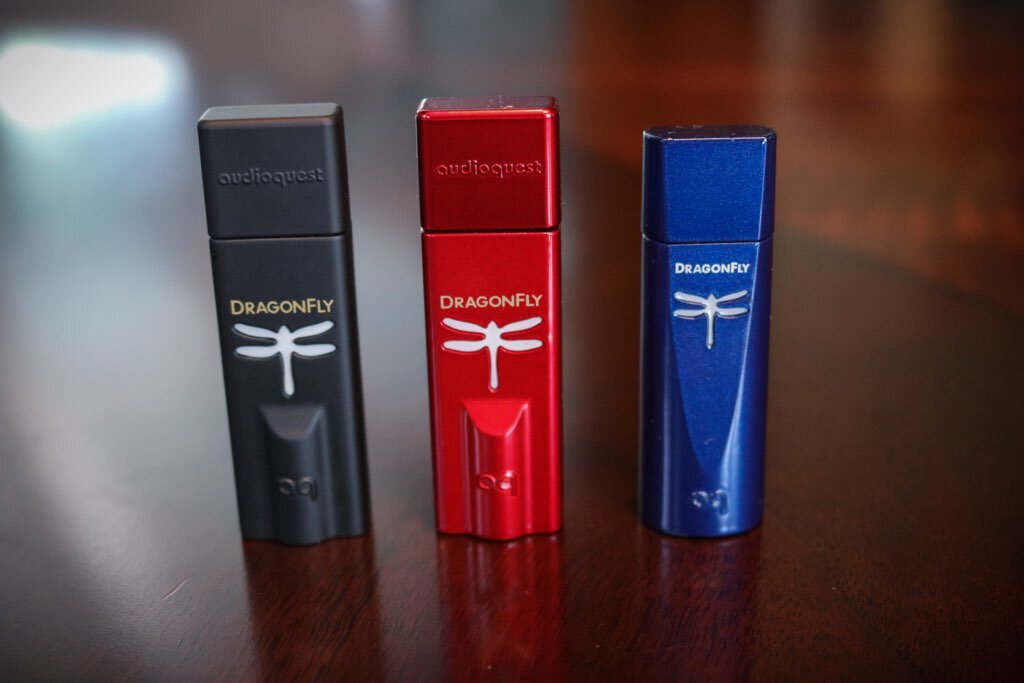THE THREE BROTHERS AUDIOQUEST—THE DRAGONFLY RED REVIEW
Wondrously musical, beautifully engaging, and exceptionally cost effective!
This then is the true story of three headphone Amps/preamplifiers/USB DACs—the DragonFly Black, Red, and Cobalt—three Brothers, if you will, their source-powered ease of use, their rising levels of musicality, resolution, engagement, efficiency, and their outstanding value to cost to musical fidelity ratio. It will be told across three distinct reviews.
Each of the three AudioQuest DragonFly headphone Amps/preamplifiers/USB DACs have been lauded by reviewers and critics alike, have made their way onto numerous “Best of the Year” lists, and have won their share of awards and accolades. One has simply but to listen to, well, any one of the Three Brothers to understand the “why” of it all. They are as listed in the subtitle of this review—wondrously musical, beautifully engaging, and exceptionally cost effective! This I’ve come to discover over many months of listening with the DragonFly Cobalt, which I had purchased independently of the review, and subsequently with the DragonFlys Red and Black which were provided for review. Further, they have opened up to the wider world the opportunity to listen to music with exceptional fidelity and at real world costs, as allied to their computers or smart devices, regardless of platform—PC, Mac, iOS, Android.
A Sound History—The DragonFlys (short)
Once upon a time—August 10th, 2012—AudioQuest (Irvine, CA) introduced its first iteration of the DragonFly series—the DragonFly 1.0. Its compact size, efficiency, musical fidelity, and the ‘housing’ of a headphone amplifier, preamplifier, and a USB DAC within its pocket-sized, metal frame, would be of signal importance to the entirety of the audio industry. And the DragonFly 1.0’s debut would spawn a multitude of ‘like’ competitors. AudioQuest would, however, continue its development with the introduction of the DragonFly 1.2 (2014), the DragonFly Red and Black (2016), and the DragonFly Cobalt (2019). For the purposes of this and coming reviews we will evaluate the DragonFly Black, Red, and Cobalt, which are all currently in production.
We begin our second review of the AudioQuest DragonFly line—The Three Brothers—with the DragonFly Red.
Dragonfly Red (Sound)
Like its sibling, the DragonFly Black, the DragonFly Red ($199) plays very well with iOS (iPhone X), Android (Samsung 10), Mac (PowerBook Pro), or PC. Inserting one’s In-Ear-Monitors (IEMs) or headphones into the DragonFly Red reveals many things over and above what the DragonFly Black so magnanimously gave. (NOTE: before playing music you may wish to reduce volume, as there is an amplifier in the DragonFly).
With the DragonFly Red the volumetric increase—height, width, depth—in the soundstage is, surprisingly almost as large as was the difference from smart device/computer direct versus the insertion of the DragonFly Black. Yes, the cube, representative of soundstage—space, distribution of performers, etc.—grows with the DragonFly Red. And the DragonFly Red facilitates a more three-dimensional rendering of space with objects more solid and well placed. But there’s more.
Relative to the Black, the DragonFly Red provides for increased transparency and refinement, which, in this case, translates to greater detail, spaciousness, a more ‘potent (as in forceful)’ and expressive sound, and a clarity to vocals unmatched by its sibling. Dynamics as well are also improved in the DragonFly Red. When you find yourself ‘bopping,’ ‘chair-dancing,’ swaying to the music it will not be accidental and the guilty party will be the DragonFly Red. In sum, it will be as if a thin veil was lifted from the face of the person in front of you and their features now come into greater relief. Or your music is laid bare beyond what you had previously experienced.
As I mentioned in the DragonFly Black review, I am neither recording engineer or allied to a record/movie production company. This gives me the leeway to listen for pleasure, unabashedly, and to pass on what I have subjectively deemed pleasurable— musically engaging, of rich timbre, of measured warmth—to those who seek the same.
Bass
David Holland’s Spheres (Emerald Tears, ECM) plays and the bass is tight, three dimensional, detailed, and wonderfully dynamic. The DragonFly Red’s bass is more substantial, tighter, and faster with greater body and layering than the Black’s. Though it too will not find the “Holy-Bass-Head-Grail (few do this well),” it will, nonetheless, come closer than its sibling and its journey will provide an expressive, more dynamic, and, dare I say, even more rewarding experience.
Midrange
Whereas there was ample body across the midrange of the DragonFly Black, the DragonFly Red provides still more body, image solidity, texture, and a clarity and expressiveness well above the Black. Voices will still be forward in the mix, yet they will be cleaner and the phrasing more easily discernible. Greater detail will also emerge with that glorious musicality and warmth present in its sibling. If you are a music lover, you will be moved. I listen to Olafur Arnald’s Raddir (Island Songs, Mercury) and the voices are ethereal, expansive, and emotive, as performed in a small, wooden church—Church of the Sailors—located on the southern coast of Iceland, which these voices fill beautifully.
Treble+
The DragonFly Red's treble is extended, detailed, airy, energetic, yet still sweet, and never harsh, never fatiguing. There is refinement across the DragonFly Red’s treble, that while more extended than the Black, it is smooth and highly engaging. I listen to Jordi Savall’s Troisième Leçon de Ténèbres à 2 voix (Tous les matins du monde, Aliavox) and the duet between sopranos—Montserrat Figueras and Maria-Cristina Kiehr—rises, falls, mingles, soars, and is impassioned, as rendered by the DragonFly Red.
Sound Summary
The DragonFly Red, for those who refuse to “let well enough alone” with the DragonFly Black and whose budgets are happily predisposed to acquiring this sibling will be greatly rewarded. It will likewise lift computer, tablet, and smartphone from their purgatory of “unmusicality” and it will even rise above the musicality and transparency of its DragonFly Black sibling. Of course, the more apt one’s headphones, then the more marked the difference and the experience will be.
Functionality
The DragonFly Red, like its sibling, represents true plug-and-play functionality and as mentioned earlier, it plays well and easily with iOS, Android, Mac, and PC. However, for USB-C terminals it will need the proper connector—USB-A (female) to USB-C (male) bridge (Dragon Tail, Apple Camera, etc.). The DragonFly Red is a source-charged (no need to pre-charge it), plug-and-play solution, that will play anything Tidal (including MQA) Spotify, and Qobuz (though its few albums above 24bit/96kHz will be made to conform to the DragonFly Red’s limit—24bit/96kHz) have to offer and beautifully so.
For the young using this DragonFly headphone amp/DACs will be second nature and for the balance of us, it may well be incredibly intuitive. Its diminutive size means that it can travel by pocket anywhere and be unleashed on-the-fly to to produce real music!
The Wrappings and Accessories—DragonFlys
The packaging for the various DragonFlys is Utilitarian-Big-Box (as in mass-market electronics store). Not particularly exciting, nor is it the embodiment of high aesthetic design. That said, it is apparently designed to price point and not to the musical bonafides of the enclosed DragonFlys, as that would require an immediate aesthetic design upgrade. But then, who buys a DAC for its packaging?
In terms of accessories you will get a decently executed, synthetic (read plastic-like, possibly rubber) pouch for protecting/containing the DragonFly DACs. Though with the DragonFly Cobalt, one will also receive a Dragon Tail—a USB-A to USB-C connector of high quality. That’s it folks, utilitarian efficiency.
The Specifications
DragonFly Red - Status/Sample rates supported (LED indicator color code):
Standby (Red),
44.1kHz (Green),
48kHz (Blue),
88.2kHz (Amber),
96kHz (Magenta),
MQA (Purple)
Volume Control: 64-bit, bit-perfect
Output voltage: 2.1
Headphone Amp: ESS Sabre 9601
DAC Chip: 32-bit ESS 9016 with minimum-phase fast roll-off filter
Microcontroller: Microchip PIC32MX
Dimensions: 12mm H x 19mm W x 62mm L
DragonFly Red—Look and Feel
The DragonFly Red is solid, of metal and thus weighty (relative to size), beautifully made, fit-in-the-palm-of-you-hand sized, that could, as mentioned in the review of the DragonFly Black, be considered a miniature Tardis (“Dr. Who” reference) for what it carries internally and what it delivers to the world.
Conclusion
The DragonFly Red represents the next elevator stop up from the Black in terms of its dynamics, transparency, and how it engages. For those who seek to go beyond the limitations of their computers, smart devices, and even the DragonFly Black, I highly recommend the DragonFly Red!
Music—Qobuz exclusively
Alexander Tharaud—Tharaud Plays Rachmaninoff
Omar Sosa—Ballads, Calma
Patricia Barber—Verse
Rickie Lee Jones—Pop Pop
Sade—Lovers Live
Sheku Kannah Mason—Inspiration
Tracey Chapman—Where You Live
Olafur Arnalds—Island Songs
Olafur Arnalds—The Chopin Project
Hilary Hahn—Tchaikovsky
Mechell Ndegeocello—Bitter
Maxwell—Maxwell’s Urban Hang Suite
Sarah Jarosh—Undercurrent
Annie-Sophie Mutter—Tchaikovsky/Korngold: Violin Concertos
London Grammar—If You Wait
Stevie Wonder—Innervisions
Alexandre Tharaud—Tharaud plays Rachmaninov
Gidon Kremer—"Preghiera" (Rachmaninov : Piano Trios)
Marvin Gaye—What’s Going On
Miles Davis—Kind of Blue
Jóhann Jóhannsson—Orphée
Ancillary Equipment
iFi xDSD
Samsung S10
iPhone X
MacBook Pro
Meze Rai Penta
Meze Empyrean
AudioQuest
2621 White Road
Irvine, CA 92614
(949) 790-6000
info@audioquest.com
www.audioquest.com
PHOTOGRAPHY—CHRISTOPHER MARKQUART


